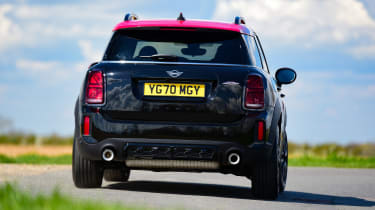MINI Countryman (2017-2024) - Engines, performance and drive
The Countryman’s ride is quite firm, but in handling and refinement terms it’s up there with the class best

Just so you know, this is an older review of the 2017-2024 MINI Countryman. If you are interested in information about the engines in the latest MINI Countryman, or news about the latest MINI models, please follow the links provided.
MINI has built a reputation for building fun to drive small cars, but as larger and more practical models arrive they threaten to erode the agile feel delivered by the core cars. Thankfully, the Countryman still has plenty of MINI DNA left in the driving experience.
This fun is evident when you get the Countryman on a twisty road. The steering is quick and there’s lots of grip on offer. Even though it has a longer wheelbase and a higher kerbweight than rivals like the Audi Q2 or Volvo XC40, the car feels more nimble and sharper to drive.
The steering is quick, especially just off centre, so the MINI darts into turns with a keenness that might take you by surprise at first. But you soon get used to this agility, and the car handles well and corners with little roll. There are different driving modes to choose from as part of the Sport Pack, and in the Sport setting the Countryman’s steering and throttle response are sharpened up. However, Mid mode is more natural, with a nicer linearity to the accelerator.
The wider track means the handling is very surefooted and composed. There’s plenty of grip, even on lesser models, and the MINI is keen to turn-in to corners with its sharp, direct steering. Even the gearshift operates with the well-oiled precision typical of a BMW Group model. It’s not as fun or engaging to drive as smaller MINIs, but by the standards of the crossover class it’s very good.
Used - available now

2022 Mini
Countryman
31,902 milesAutomaticPetrol1.5L
Cash £20,567
2022 Mini
Countryman
27,194 milesAutomaticPetrol1.5L
Cash £25,409
2022 Mini
Countryman
30,449 milesManualPetrol1.5L
Cash £18,189
2022 Mini
Countryman
23,412 milesAutomaticPetrol1.5L
Cash £19,951Happily, MINI has also managed to match composed handling with mature cruising ability. The ride is a bit firm at times – particularly on models with larger wheels – as potholes and torn surfaces unsettle the car. Vertical movements are evident at higher speeds, but the Countryman is never too uncomfortable thanks to good damping. Optional Dynamic Damper Control allows this to be adjusted according to the road surface and the driver’s preference.
Despite some tyre roar on bad surfaces, the Countryman is among the more refined cars in its class, with excellent isolation from wind and engine noise. Visibility is okay, and it’s easy to place the corners of the car when manoeuvring and parking.
0-62mph acceleration and top speed
The base Cooper uses the same 1.5 litre three-cylinder turbo petrol engine found in the MINI hatch and Clubman. With 134bhp and a decent 220Nm of torque most should find it a characterful offering, although the power may feel a little sapped if loaded with kids and luggage, particularly as the Countryman isn’t all that light.
Buyers opting for the Countryman Cooper S version will find a 2.0-litre four-cylinder petrol engine producing 176bhp and 280Nm of torque. While it’s smooth and torquey, it doesn’t really live up to the brief of being a hot crossover. Outright performance is adequate but not sparkling.
The Countryman JCW ups power to 302bhp and provides the performance kick that's missing in the Cooper S. It manages 0-62mph in 5.1 seconds, before hurtling on to a 155mph maximum.
With a system output of 217bhp and rear-mounted electric motors creating all-wheel drive, the Countryman PHEV is a brisk car too – getting off the line from 0-62mph in 6.8 seconds. It's also got a sporty three-cylinder note and lots of torque, but the performance tails off at higher speeds. It'll score highly with company car drivers though, thanks to the potential for rock-bottom running costs.






